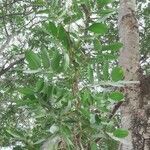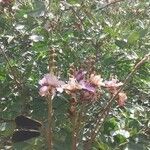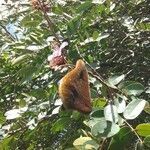A tree. It grows 10-17 m high. The crown is round. The young bark is smooth and grey but becomes rough and cracked when old. It loses its leaves. The young branches are hairy. The leaves have leaflets. There are 4 or 5 leaflets. These have rusty brown hairs. The leaflets are 4-7 cm long by about 2 cm wide. They vary in shape. There are up to 40 flowers in a group 4-35 cm long. Only 1 or 2 flowers produce fruit and the rest fall off. The fruit are pods 8-14 cm long by 4-5 cm wide and broadly sword shaped. They split into 2 twisted valves. The seeds are dark red-brown. They are 2-2.5 cm long by 1.5-1.8 cm wide.
Racemes 4–35 cm long, ± erect, brown-pubescent to-tomentose, with up to 40 flowers regularly alternately arranged on opposite sides, the rachis consequently somewhat zigzag, most flowers (except usually one or two which produce fruit) falling with pedicel to leave a prominent ledge (bract scar) at each node of the otherwise denuded rachis; bracts c.4 × 5 mm, ovate to semicircular, caducous; pedicels c.9–13 mm, with prominent bracteole scars c.1–3 mm. from the base; bracteoles 4–5 × 3–5 mm, broadly ovate to broadly elliptic, usually rounded at apex, quickly caducous.
Calyx 13–20 mm long, divided to the base into 4 lobes of which the upper (adaxial) is 7–10 mm broad, the lateral one 4–7 mm broad, and the lower (abaxial) one 3–5 mm broad and slightly the longest through curvature, all brown-pubescent to-tomentose outside except on the overlapped margins 0.5 mm broad, and pale brown-tomentose inside.
Stamens 10, about equalling the petals, one free, nine lightly fused towards the base, the lower part villous and the free part glabrous; anthers (3.5)4–5 mm long, versatile.
Petals 5, 2.3–3.0(3.5) cm long, obovate-spathulate, pale mauve to bluish-purple, undulate at lower margins, villous towards midrib especially near base.
Round-topped tree usually 10–17 m high, occasionally reaching 25 m; young bark smooth and grey but becoming rough and fissured when old; deciduous.
Young branches pubescent to tomentose with appressed or ascending rusty-brown hairs, but quickly glabrescent to leave a smooth grey bark.
Pods 8–14 × 3.5–4.7(5) cm, oblanceolate with oblique apex, woody, brown-tomentose, dehiscing into two spirally twisted valves.
Ovary 12–15 × 4–5 mm, obliquely oblanceolate, brown-tomentose; style slightly exceeding petals and stamens; stigma capitate.
Seeds dark reddish brown, 2–2.5 × 1.5–1.8 × 3 mm, elliptic-orbicular, compressed.




